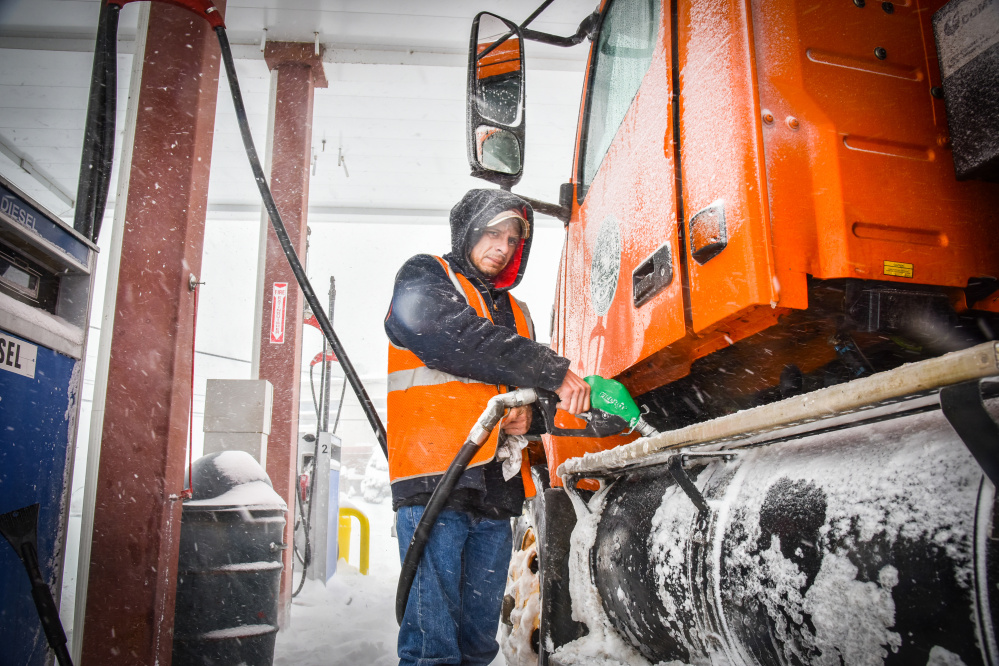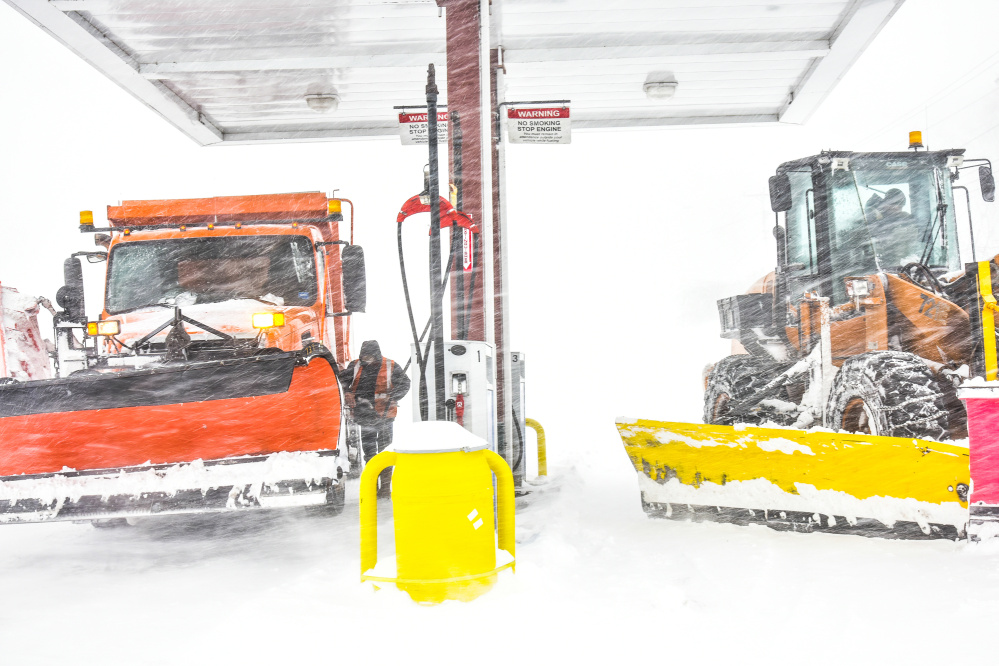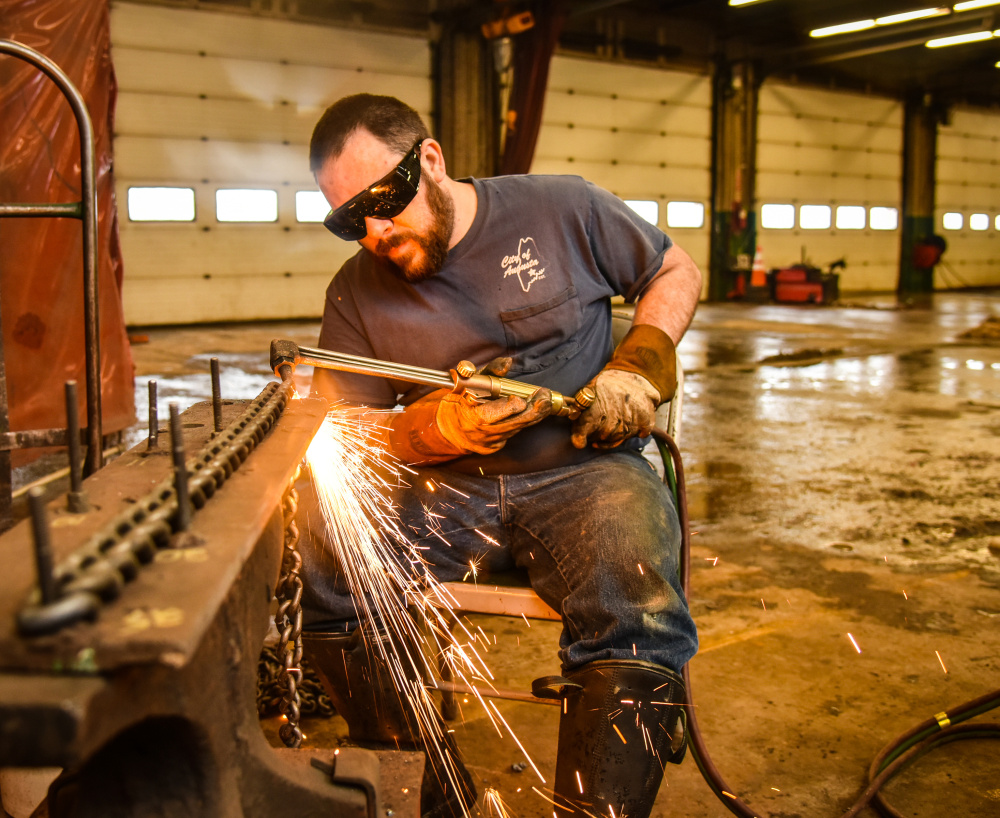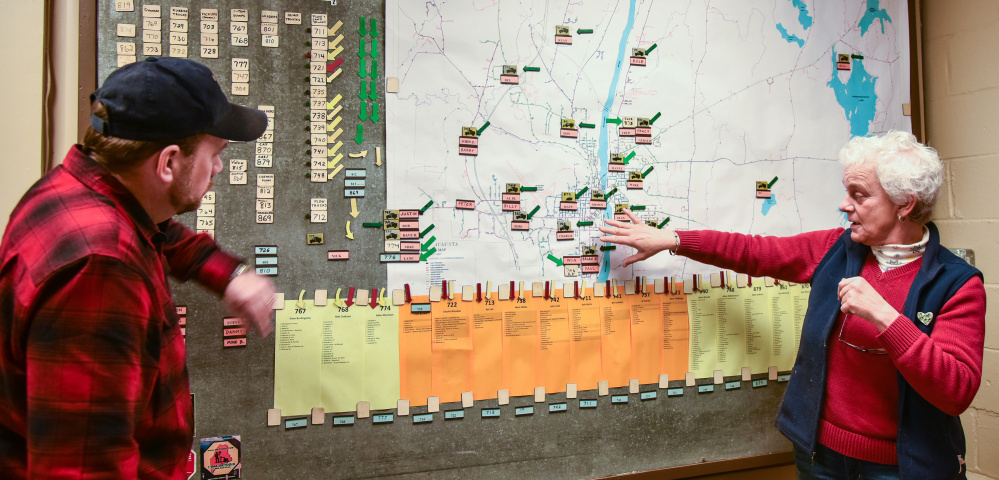AUGUSTA — As snow continued to fall relentlessly outside, making it impossible to see what was going on just a few feet away from the garage bays at Augusta Public Works’ headquarters off North Street, public works officials looked at the big sheet of metal mounted on the wall covered with a map of the city’s roughly 300 miles of road lanes.
Lesley Jones, public works director, and Jerry Dostie, street superintendent, had a tired group of drivers who’d been on the road for more than 12 hours about to finish their shifts. They needed to fill the gaps in manpower even as the amount of snow falling and blowing around tested the limits of their ability to remove it safely.
With 21 plow routes covering the city, eight drivers about to come off the road, and only three drivers scheduled to take their place, filling the gaps appeared to be like trying to complete a puzzle that doesn’t have all its pieces.
In this case, they needed drivers to fill every shift behind the wheel of a big orange truck with a load of sand in the back and plow gear hanging off the front, fighting whiteout conditions to plow snow from city streets.
Jones said they try not to have any drivers on the road for more than 16 hours straight. To avoid driver fatigue they give them a chance to go home and rest and, in many cases, remove snow from their own driveways before they’re scheduled to come back in.
“The human body can only take so much,” Jones said. “It’s key to get people home to get some rest and take care of things at home.”
Plow truck drivers wrapping up their long shifts between noon and 2 p.m. Monday would likely be coming back in to plow some more beginning at 1 a.m.
Tom Brown’s city plow truck had an air leak in its braking system. He brought it in shortly before noon Monday, and mechanic Greg Willis, of Vassalboro, immediately slid underneath to fix it so Brown could get back out on the road. Brown started at 7 a.m. as part of the fourth round of plowing by city crews since they started plowing around 4 p.m. Sunday. When asked how long he’d be there, Willis pointed to Dostie and said, “That’s up to him.” Jones and Dostie said they anticipated that shift of drivers would probably remain on the job until around 10:30 p.m., a 15-and-a-half-hour shift.
All while they may have family members at home relying on them to plow and shovel snow there, when they can get to it.
Brown, of Winslow, said his two kids and girlfriend know that he won’t be home to remove snow from his personal driveway until after his shift is done.
Willis said he plowed his own driveway out before he started work and will plow it again after his shift is done. He gave his wife a ride to work at the hospital before coming in. He said his wife can plow out their yard, too, in their pickup truck with a plow.
Willis’ typical shift during a snowstorm is filled with repairing and replacing cutting edges on plows, which are metal blades that scrap snow off the pavement; fixing hydraulic hoses; replacing electric plow motors; replacing wings that come off trucks; fixing electrical problems; repairing and rebuilding chains that go on the tires of loaders and other equipment; and any other repair needed.
Jones said at least one mechanic is in the garage whenever crews are out plowing.
Dostie said plowing can be a stressful job, especially in conditions like Monday’s, with blowing snow making it hard to see more than a few feet ahead. He said sometimes drivers find the road they’re trying to plow by spotting utility poles and mailboxes along the side of the road.
Monday morning brought at least two collisions between city plow trucks and equipment driven by private plowers, neither of which injured any of the drivers involved. Brown’s truck bumped tires with a front loader being driven by a private contractor as Brown was backing up, but didn’t damage either vehicle. He said they couldn’t see each other in the whiteout conditions.
The recent run of snowstorms coming on the heels of previous snowstorms makes it difficult for city crews to keep up with the need to remove plowed snow from sidewalks and piles alongside the road in between storms.
Dostie noted the city only has one plow crew, and those workers are the same ones responsible for removing snow from sidewalks and city streets which can become narrow as the snow piles up.
“We only have one crew. They can’t be plowing and remove snow at the same time,” Dostie said.
Dostie and Jones asked for patience from motorists and residents. Jones said it may not be until Wednesday before any plow drivers will be able to switch over to any of the city’s three sidewalk plows. However, Wednesday may also bring another snowstorm to deal with, too.
The metal board with a city map attached to it was covered Monday morning with magnetized miniature cutouts of plow trucks spread across city streets, each with an arrow — the position of which indicated how long that driver had been on the road — and a driver’s name with it. Jones said that’s how they keep track of which driver is on which route. Supervisors out in the field, who are also plowing as they supervise, keep track of the whereabouts and status of their group of drivers more closely, keeping in contact by radio. Jones said if they can’t reach someone on the radio, they’ll go check their route to find them to make sure they’re OK and haven’t gone off the road.
The city’s 21 plow routes include nine main routes and seven city residential runs, both plowed by dump trucks, and five runs on more narrow streets plowed by pickup trucks with plows.
Jones said the priorities are generally keeping core major roads open and keeping rural roads plowed, so both will be drivable should police, ambulance or fire crews need to use them to get to an emergency with smaller, shorter residential roads less of a priority.
Dostie said it can take between an hour and four hours to complete a plow route. If it is snowing hard, like it was Monday, several inches of snow can accumulate on some roads before the plow will be back around to plow it again.
Jones said completing the snow removal task would be easier with three or four more drivers, but city budget cuts in recent years have limited the size of the available crew.
Dostie said the job is made more difficult by people removing snow from their driveways and putting it out in the street, which is against both state law and city ordinance.
He said doing so puts drivers in danger because in whiteout conditions they may not be able to see snow piles that have been put out in the road from residents’ driveways. Jones said it also further narrows city streets.
They also both said motorists can help by giving the large, heavy plow trucks plenty of room on the road.
Keith Edwards — 621-5647
Twitter: @kedwardskj
Send questions/comments to the editors.







Comments are no longer available on this story